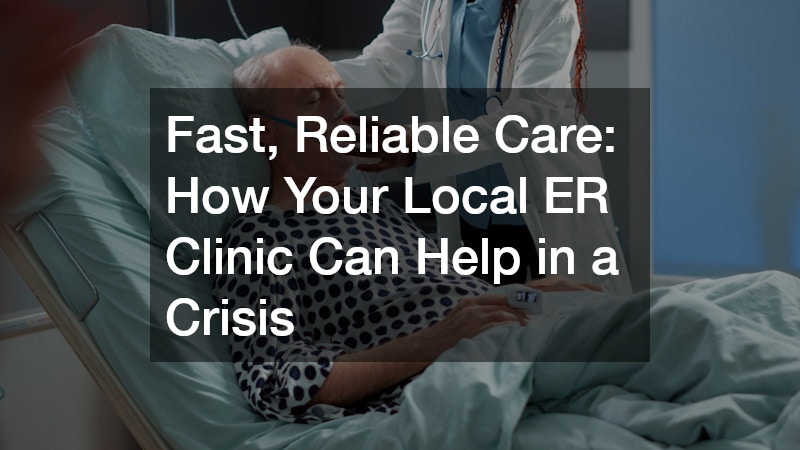Disclaimer: This website provides health information for educational purposes only and is not a substitute for professional medical advice, diagnosis, or treatment. Always seek the guidance of a qualified healthcare provider with any questions you may have.
In a medical crisis, knowing where to turn for immediate and efficient care can make all the difference. Local ER clinics play a crucial role in providing fast, reliable care during emergencies. This article explores how these clinics function, address common concerns, and illustrate their significance in crisis situations.
Comprehensive Emergency Care
Local ER clinics are crucial in the healthcare landscape, offering a broad spectrum of emergency services. They are staffed by experienced medical professionals capable of handling a variety of acute medical conditions. From minor injuries to serious illnesses, these clinics ensure patients receive the necessary medical attention promptly.
Such facilities are equipped to manage conditions like fractures, sprains, lacerations, and even heart attacks or strokes in their initial stages. The availability of onsite labs and imaging services facilitates rapid assessment and treatment initiation. This comprehensive approach ensures that patients receive holistic and immediate care, minimizing complications from delayed treatment.
Advanced Diagnostic Resources
Local ER clinics boast advanced diagnostic equipment that helps in swift and accurate medical evaluations. These clinics often house state-of-the-art imaging technologies such as X-rays, CT scans, and ultrasound machines. The availability of these resources ensures that healthcare providers can quickly identify the nature of a medical issue and decide on the best course of action.
In addition to imaging technologies, many ER clinics have on-site laboratories, allowing for immediate processing of blood work and other critical analyses. Rapid access to diagnostic data significantly reduces wait times for test results, allowing for faster implementation of treatment plans. This immediacy is crucial in emergency situations where every minute counts in preventing the progression of a condition.
Streamlined Triage Processes
Streamlined triage systems are a hallmark of efficient ER clinics, designed to assess and prioritize patient needs quickly. By categorizing patients based on the severity of their conditions, these clinics ensure that those requiring immediate attention are treated first. The triage process, managed by skilled healthcare professionals, reduces wait times and aligns resources with patient demands effectively.
The use of triage in ER clinics is supported by established protocols that enable swift decision-making. Through quick assessments and continuous monitoring, healthcare professionals maintain a dynamic response to patient needs. This rapid adaptability ensures that critical cases receive expedited care, potentially improving patient outcomes in life-threatening situations.
Location and Accessibility
The strategic placement of local ER clinics is integral to reducing critical response times during emergencies. Often located within community-centric areas, these clinics ensure that medical care is never too far away when an urgent need arises. Their accessibility is designed to provide patients with a convenient option compared to larger, centralized hospitals that might be located several miles away.
Choice of location for ER clinics takes into account factors such as proximity to densely populated regions and ease of access via major roads. This thoughtful positioning significantly reduces the time it takes for patients to reach these facilities, particularly during emergencies where every moment is vital. By being accessible, ER clinics contribute to the overarching goal of improving public health response times in crisis conditions.
Reduced Wait Times
Local ER clinics often present significant advantages over hospitals, one of the most notable being reduced wait times. With fewer patients to manage simultaneously, these clinics can attend to individuals with much swifter efficiency than many overcrowded hospital emergency rooms. This expedited service is crucial in medical emergencies where delays can exacerbate health conditions negatively.
The operational model of ER clinics is fine-tuned to provide rapid assessments and interventions. This efficiency is achieved through a combination of organized triage processes and focused patient care strategies. Consequently, individuals seeking prompt medical attention find local ER clinics a reliable alternative during critical times.
Focused Patient Care
One of the defining characteristics of local ER clinics is their ability to deliver focused and personalized patient care. With a smaller and more manageable influx of patients, healthcare providers can afford the time to engage with individuals on a more personal level. This attention to detail fosters a supportive environment where patients feel valued and understood.
Local ER clinics are an invaluable resource during medical emergencies, offering rapid, reliable, and cost-effective care. Understanding their services, response time mechanisms, and benefits over traditional hospital settings can better prepare individuals for unforeseen crises and ensure they receive the necessary care swiftly. As communities continue to navigate challenges in healthcare accessibility and efficiency, the strategic placement and operational efficiency of local ER clinics remain crucial.
The essence of ER clinics lies in their ability to offer specialized, immediate, and personalized care, driving their indispensable role in providing emergency medical services. As individuals become more aware of these facilities’ accessibility and benefits, utilizing ER clinics can be a proactive choice, ensuring timely and effective medical intervention when it truly matters.





